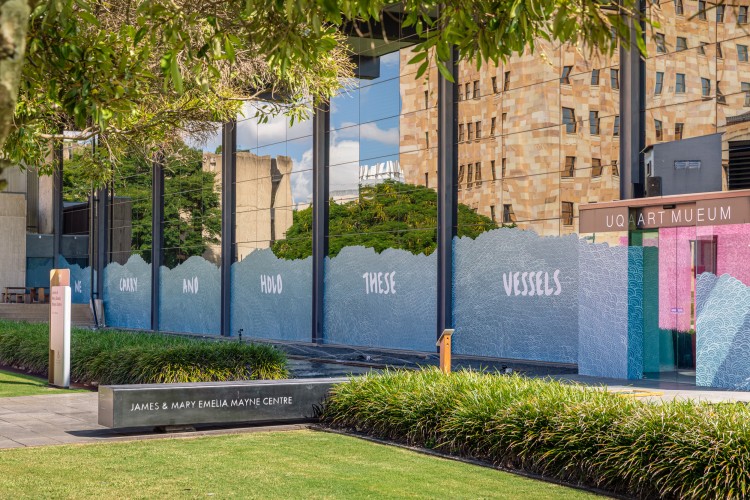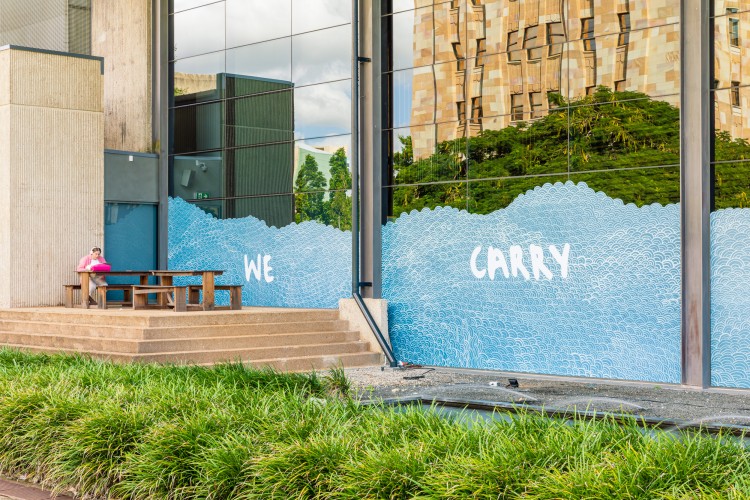Sancintya Mohini Simpson, Vessel/Vessel, 2022. UQ Art Museum Window Commission.
Sancintya Mohini Simpson, Vessel/Vessel, 2022. Poem, ink on wall.
Sancintya Mohini Simpson, Ṭāpū, 2022. Watercolour and gouache on handmade wasli paper, triptych.
Isha Ram Das and Sancintya Mohini Simpson, Vessel, 2022. Installation, multi-channel sound, corrugated iron, timber, earth, ash, clay lotas.
“Sibling artist duo Sancintya Mohini Simpson and Isha Ram Das are descendants of indentured labourers sent from India to work on colonial sugar plantations in the colony of Natal (now KwaZulu–Natal, South Africa). Together their work charts the complexities of migration, matrilineal memory and trauma, addressing silences within the colonial archive.
Vessel (2022) is a large-scale sound installation by the artists, which reframes colonial histories and perspectives on Indian indentured labour through experimental sound. Inside a makeshift housing structure, mounds of aromatic earth support clay lota vessels emanating an arresting soundscape. The audio acknowledges the history and lived experiences of those taken from India to South Africa during the late 1800s and the early 1900s. As a form that carries, both literally and metaphorically, the clay lota vessels become ancestral objects that deliver these histories through song and enacted ritual.
Here, the artists’ work reorients ownership of this history and pays homage to those forgotten, who were sent out across the ‘dark waters’ of the Indian Ocean to Natal. While these works refer directly to the South African sugar cane plantations, they are in parallel to the local and often-absent stories of what is known as ‘blackbirding’ in Australia—the practice of kidnapping South Sea Islander communities and their forced labour on sugar cane farms.
Indian miniature painting historically focused on privileging the dominant gender, caste, and class, often omitting the daily lives and experiences of women. In Ṭāpū (2022), Sancintya Mohini Simpson employs miniature technique charting the violence of indenture across the Indian Ocean to Natal, with two protagonists; a casteless woman adrift in an oceanscape, and the vessel of a colonial ship. The woman is submerged under the waves of a tumultuous sea, seemingly cast overboard, and the tall ship continues on out of frame.
Ṭāpū can be understood across many diasporic languages of South Asia—Sanskrit, Marathi, Hindi, among others—as taboo; island; a body surrounded by water on all sides; or the exiling of a person from the mainland. Here in relation to indentured labour, Simpson takes a little-known South African Bhojpuri definition of Ṭāpū to mean, “anyone who disappeared from the village (absconded, lost, or murdered) was said to have gone to Ṭāpū, so there was an evil association…” The slippage of language here is important, as Ṭāpū took on new meaning through the forcible displacement of communities, across oceans, to the sugar cane fields of Natal.
Upon the backdrop of a stormy wavescape, the commission of Vessel/Vessel (2022) on the front windows of UQ Art Museum pulls a phrase from her adjacent poem ‘we carry and hold these vessels.’ Here, the word ‘vessel’ is interchangeable to mean body, water, boat, and by extension, museum, as a site of the ongoing colonial project. Simpson gestures to ancestral ‘black waters’, both consumed and embodied, but also to submerged futures due to sea-level rise.”
(Translation reference: Tinker, Hugh in Rajend Mesthrie (ed), “New Lights from Old Languages: Indian Languages and the Experience of Indentureship in South Africa,” in Essays on Indentured Indians in Natal, p.198, 1988) – Blue Assembly: Oceanic Thinking, UQ Art Museum, Brisbane 2022 (curated by Peta Rake).







































